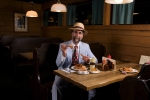A friend at Pace referred a student to me who had some questions about a career in journalism. Here’s what I had to say to him:
Jonathan,
You asked, “Could you tell me a little bit about your job, your experience with journalism, and any advice/insights you’ve learned while figuring out what you wanted to do?” Your question, though an excellent one, proved a lot more difficult to answer than I anticipated. Just what advice does an editor who got laid off after 35 years in journalism give to a student who’s weighing the pluses and minuses of a career in journalism? Our era’s almost obligatory and, to my taste, Panglossian answer has become, “Follow your dreams. Go for it.” But being a curmudgeon and cynic from birth, I wouldn’t have given you that advice decades ago when journalism was considered glamorous after Deep Throat spurred thousands enter the field. When I became a journalist, newspapering was, at best, marginal. “Scoop” my friends derisively called me.
I sure wasn’t following my dream when I went to work for the Winston Salem Journal in 1974. I was just trying to find something else to do other than teaching Latin to rich, spoiled prep-school students. Joe Goodman, a Duke art-history grad who was one of the sharpest editors and best teachers I ever encountered, hired me, though I hadn’t spent a minute in a journalism class. I won’t bore you with the details of my newspaper career. Hitting the highlights, though, I started out doing weather and obits at the Journal and ended up helping the paper to win the N.C. Press Award for investigative reporting. You could do that back then. “Defend yourself,” Goodman would say, coming to each desk with his clipboard. As long as you could come up with a story idea better than the routine ones he had listed, a reporter could chase any story he or she wanted to. At Cocoa TODAY, the prototype for USA TODAY, I covered the Space Shuttle as it tried to escape the Earth’s and technology’s grip. At the Jacksonville Times-Union, I got to watch brain and heart surgery. And I also spent Christmas in Beirut.
I loved every minute of it. I loved working with a cast of original characters – and drinking way too heavily with them night after night. I loved the juice and the feeling of being on a winning team, something I’d never experienced before. I remember someone coming into the Journal newsroom and complaining to the managing editor that I was being way too hard on them. A Lucky Strike in the corner of his mouth, the M.E. led the complainant out into the newsroom and pointed at the host of misfits out there, many typing with one finger. “You think Bailey’s bad. I got lots more like him and if you don’t get out of here, I’ll have every one of them on your case.”
I also loved the feeling of privilege being a reporter gave me, meeting everyone from film producers to presidents, and being able to ask any one of them anything I wanted, at any time. Most of all, I loved getting paid for doing things like watching shuttle engines blow up in Bay St. Louis where the Louisiana crayfish were plentiful, cheap and delicious; riding a horse through the Mayan jungle to poke around in unexcavated pyramids; eating lunch overlooking Beirut in a dining room which had a hole punched in the wall by the USS New Jersey. I probably should have been willing to move north and sign onto a first-rate paper, but I didn’t wanna. And back then, if you were good and in demand and winning prizes, you could have a great career and earn good money and avoid doing what you didn’t wanna do.
Looking back, I guess I worked in the golden age of American newspapering.
But what I most wanted to do was to work for magazines. A friend from Winston-Salem Journal of Marxist leaning published one in my home state, Business North Carolina, and I went to work for him, spending months on stories instead of days. I loved it even more than newspapering, loved figuring out what made companies tick — or not tick — loved writing profiles of the richest and most powerful people in the state. And I discovered that I loved fixing other people’s prose. As I moved from BNC to Sky, I realized that it was fun dispatching others to exotic places to chase their dreams — maybe not quite as much fun as paddling the Amazon River or running in the amateur Olympic games in Greece or searching for the best soft-shelled crab sandwich in Maryland. But concepting and assigning stories and ultimately coordinating special issues, like our all-coffee issue or our all-pet issue, was exhilarating and rewarding. But what I discovered I liked more than anything else about journalism was working with a group of smart and gifted people who are passionate and totally committed to sharing stuff they really find neat with the rest of the world — and, again, drinking way too much with them.
When you’re part of a band like that, making music that your audience and cohorts tell you is first-rate, life is just about as good as it gets. It’s a dream job. So what if it doesn’t last forever — what does? So what the hell. Who am I to discourage you? Follow your dream if your dream is to do journalism. Mine still is.
David
 unemployed, along with something like 500,000 of my fellow Tarheels. Despite a very generous and supportive chance by Dennis Quaintance and Mark File to discover whether or not my talents lie in marketing (They do not), I am still searching for a permanent job.
unemployed, along with something like 500,000 of my fellow Tarheels. Despite a very generous and supportive chance by Dennis Quaintance and Mark File to discover whether or not my talents lie in marketing (They do not), I am still searching for a permanent job.
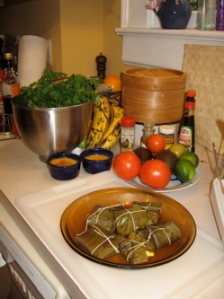
 k
k
 No use pointing out that the wingtips I’d been wearing for months had only some superficial nicks. And who would notice that one sole was melted from standing atop an eight-burner industrial stovetop to wash down the stainless-steel hood above it.
No use pointing out that the wingtips I’d been wearing for months had only some superficial nicks. And who would notice that one sole was melted from standing atop an eight-burner industrial stovetop to wash down the stainless-steel hood above it.
 • for seeing something in me 45 years ago that no one else in Reidsville—or on the planet—saw
• for seeing something in me 45 years ago that no one else in Reidsville—or on the planet—saw
 I’ve moaned and I’ve groaned about being unemployed but it’s about time I came clean with a little bit about the flip side. For instance, it’s around 10:30 and I just finished a brunch of stone-ground grits, amplified with pimento cheese and Iberian ham, sprinkled with Hungarian bacon and topped with a lightly poached egg. Texas Pete found a place at the table, of course, and there were some fresh tomatoes topped with mayo.And, oh yes, of course, a double espresso made with my beloved Francis Francis (this is actually my old model, which is visually more interesting)
I’ve moaned and I’ve groaned about being unemployed but it’s about time I came clean with a little bit about the flip side. For instance, it’s around 10:30 and I just finished a brunch of stone-ground grits, amplified with pimento cheese and Iberian ham, sprinkled with Hungarian bacon and topped with a lightly poached egg. Texas Pete found a place at the table, of course, and there were some fresh tomatoes topped with mayo.And, oh yes, of course, a double espresso made with my beloved Francis Francis (this is actually my old model, which is visually more interesting)
 , but any barbecue is better than a burger from one of the chains that have popped up along Highway 52.
, but any barbecue is better than a burger from one of the chains that have popped up along Highway 52. After the rigors of dish washing, which I’m still doing on a regular schedule, anything else may sound like a holiday. The backline, though, turned out to be a trial by fire rather than by dish water.
After the rigors of dish washing, which I’m still doing on a regular schedule, anything else may sound like a holiday. The backline, though, turned out to be a trial by fire rather than by dish water.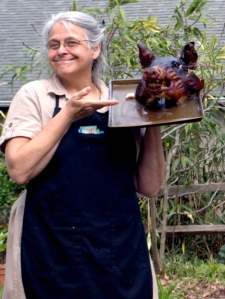
 An hour later—or maybe it was two hours later—I rechecked the temperature and it held steady at 250. This hog cooking wasn’t that hard, I remember thinking, but sitting in a lawn chair was uncomfortable, and I knew that the further I was from the cooler of beer, the better off I’d be, so I decided to grab a cat nap. I set the timer on our microwave oven, which beeps insistently, and lay down on the couch. At 5 a.m., I awoke to insistent beeping and rushed outside. The temperature had plummeted to 190, although the quickest glimpse showed a beautifully browned exterior. However, I was sure that five hours hadn’t been long enough to cook a whole hog.
An hour later—or maybe it was two hours later—I rechecked the temperature and it held steady at 250. This hog cooking wasn’t that hard, I remember thinking, but sitting in a lawn chair was uncomfortable, and I knew that the further I was from the cooler of beer, the better off I’d be, so I decided to grab a cat nap. I set the timer on our microwave oven, which beeps insistently, and lay down on the couch. At 5 a.m., I awoke to insistent beeping and rushed outside. The temperature had plummeted to 190, although the quickest glimpse showed a beautifully browned exterior. However, I was sure that five hours hadn’t been long enough to cook a whole hog.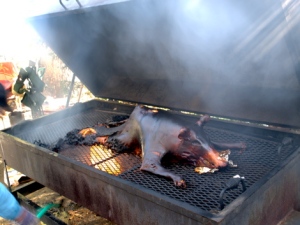 The entire hindquarters was aflame and you could see blackened bones sticking out of the hams. The phrase “flaming asshole” came to mind.
The entire hindquarters was aflame and you could see blackened bones sticking out of the hams. The phrase “flaming asshole” came to mind.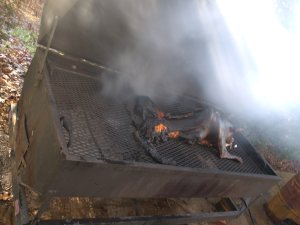
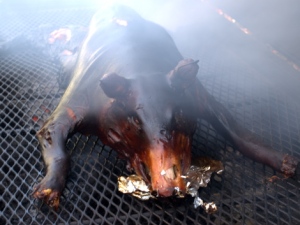
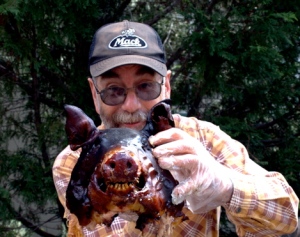
 So . . . “What’s it like?”
So . . . “What’s it like?”


